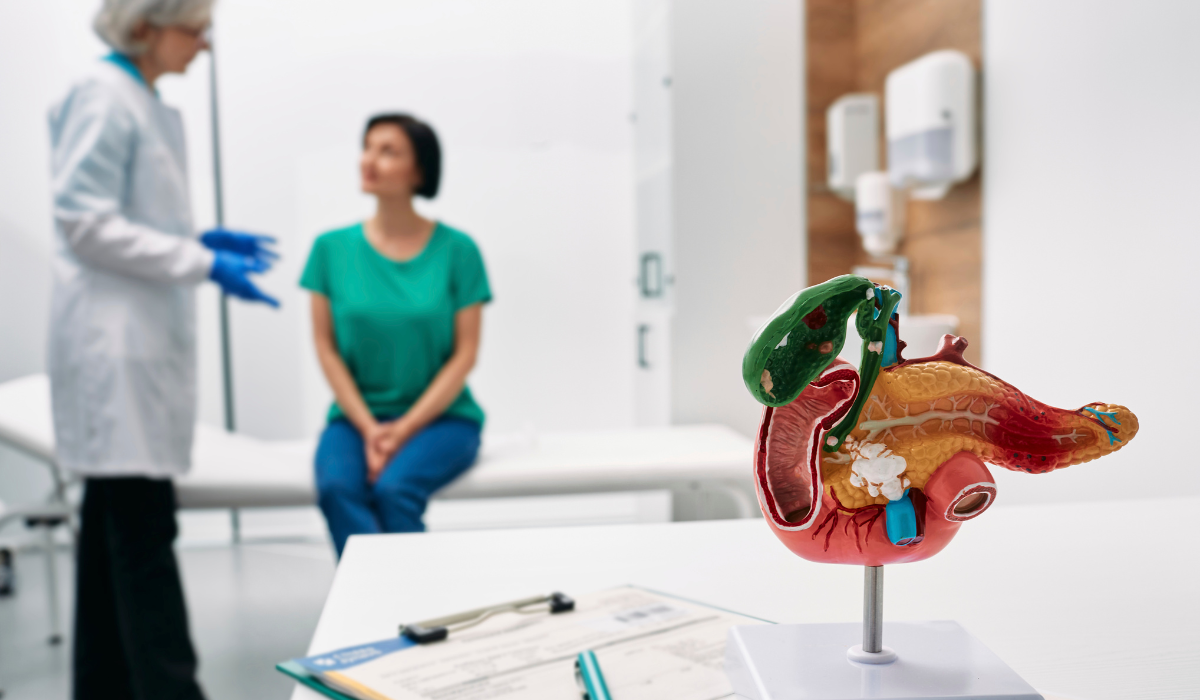About The Pancreas

The pancreas is an organ that plays an important role in your digestive system and is part of your gut (gastrointestinal tract). It helps break down food as we eat and turn it into energy for our cells.
What does the pancreas do?
The pancreas has two main functions in the body: exocrine (digestion) and endocrine (regulating blood sugar).
Exocrine Function
The exocrine function of the pancreas is responsible for creating and releasing natural juices, called digestive enzymes, into the small intestine. These digestive enzymes break down nutrients in food, so the body can properly absorb carbohydrates, proteins, and fats.
The enzymes your pancreas makes are:
- Amylase. Amylase helps break down starchy foods and other carbohydrates into easily absorbable simple sugars.
- Protease. Protease helps break down protein in food into amino acids.
- Lipase. Lipase works with bile (a fluid produced by the liver) to help break down fats in food.
Once food enters your stomach, the pancreas begins releasing these digestive enzymes through small ducts (tubes), moving them into the first part of the small intestine, called the duodenum. Bile also moves into the duodenum from the liver, mixing with the enzymes to start breaking down food.
Endocrine Function
The endocrine system of the pancreas is made up of pancreatic islet cells, which are responsible for producing hormones that release into your blood and send signals to other parts of your digestive system. These hormones help regulate blood sugar levels, so your body can properly function.
The hormones your pancreas makes are:
- Insulin. Insulin is a hormone that helps the body absorb glucose. When blood sugar levels are high, insulin is released into the bloodstream to lower them. Insufficient amounts of insulin cause high blood sugar levels, which can lead to the development of diabetes.
- Glucagon. Glucagon is a hormone that tells the liver to release glucose into the bloodstream. When blood sugar levels are too low, the pancreas releases glucagon, signaling the liver to release stored glucose, raising blood sugar levels.
- Gastrin and amylin. Gastrin stimulates your stomach to produce gastric acid, which allows the stomach to digest and absorb the proteins and vitamins from food. Amylin helps control appetite and regulates gastric emptying (moving food along the digestive tract).
The types of pancreatic islet cells include:
- Alpha (α) cells. α-cells make up about 30% of islet cells and produce glucagon.
- Beta (β) cells. β-cells are the most common type of islet cell. They make up about 60% of islet cells and produce insulin.
- Delta (δ) cells. Δ-cells make up about 10% of islet cells. δ-cells secrete somatostatin, a peptide hormone that helps maintain homeostasis in the body by preventing the release of pancreatic hormones such as insulin and glucagon.
- Epsilon (ε) cells. ε-cells produce ghrelin, a type of hormone that is secreted in both the stomach and the pancreas. ε-cells make up 1% of islet cells. Ghrelin is also known as the “hunger hormone” due to its ability to send signals to the brain when the stomach is empty.
- Gamma (γ) cells. γ-cells are also known as pancreatic polypeptide-producing (PP) cells. γ-cells make up about 1-2% of islet cells in the pancreas and signal the brain when the stomach is full.
Where is the pancreas located?
The pancreas is located in the left quarter of your abdomen, right behind your stomach and in front of your spine. It is between 6 to 10 inches (15-24 cm) long, or about the length of a dollar bill. It is connected to both your gallbladder and your small intestines.
Pancreas Anatomy
The pancreas is typically divided into four parts:
- Head. The head is the widest part of the pancreas and lies within the C-like curve of the duodenum.
- Neck. The neck is short and is located between the head and the body of the pancreas.
- Body. The body is the central part of the pancreas and lies behind the stomach and left of the superior mesenteric vessels.
- Tail. The tail is the thinnest part of the pancreas and lies at the left end close to the spleen. It is the only part of the pancreas that is intraperitoneal, meaning it crosses into the area that contains other abdominal organs.
Diseases of the Pancreas
The pancreas is an important part of regulating the body’s blood sugar and digestive system. When the pancreas becomes diseased, it may have trouble performing its usual functions, like releasing insulin and glucagon, as well as making digestive enzymes.
There are 3 primary diseases that affect the pancreas:
- Pancreatitis. Pancreatitis is the inflammation of the pancreas. There are 3 types. Acute pancreatitis (single episode) is the inflammation of the pancreas over a short period of time. Recurrent acute pancreatitis (RAP) consists of recurring episodes of inflammation. Chronic pancreatitis is when there’s recurring, persistant inflammation in the pancreas, which can cause permanent damage and scarring. This can cause ongoing digestive problems and may eventually lead to diabetes.
- Pancreatic Cancer. Pancreatic cancer is the formation of malignant cancer cells in the tissues of the pancreas and may cause jaundice, abdominal and back pain, loss of appetite, and weight loss. It is often difficult to diagnose pancreatic cancer as the symptoms are vague. Usually, pancreatic cancer is diagnosed at an advanced stage, making effective treatment difficult.
- Diabetes. Diabetes is a chronic condition that affects the way the body processes sugar. This is often due to a lack of insulin secretion, leading to high blood sugar levels. There is a high correlation rate between diabetes and pancreatitis. Those with type II diabetes may be at a higher risk of developing pancreatitis.
Pancreas Pain: What to Know
Pancreas pain is defined by severe pain in the abdomen. It can occur suddenly, generally after eating or drinking, and last for a prolonged amount of time.
What does pancreas pain feel like?
Pancreas pain is felt on a spectrum. This spectrum can range from severe and sharp to dull and continuous. Pancreas pain typically starts in the abdomen. The level of pain differs from person to person; not all patients experience the same levels of pancreas pain.
Where is pancreas pain felt?
Pancreas pain is generally felt in the upper abdomen. It can also spread to the back, chest, stomach, and ribs.
What causes pancreas pain?
Pain in the pancreas is caused when the pancreas is inflamed, swollen, or irritated. It could be an early sign of pancreatic problems, specifically pancreatitis. Pain often flares up a few minutes after eating or drinking. Other factors can also contribute to pancreas pain.
Learn more about pain management.
Can you live without a pancreas?
Yes, it is possible to live without a pancreas. Pancreas removal surgery, or the Total Pancreatectomy with Islet Autotransplantation (TPIAT), is the main surgical procedure to treat diseases involving the pancreas. During TPIAT, the pancreas, duodenum, and spleen are removed. It also involves taking your islet cells and putting them in the liver to minimize the risk of diabetes.
The TPIAT may help with pancreas pain; however, having the TPIAT should be carefully thought out and other non-surgical options should be considered first. This is because the surgery has life-long risks, such as dependence on pancreatic enzymes, increased risk of diabetes, and other complications.
Learn more about the TPIAT.
Key Takeaways
- The pancreas is a digestive organ that helps the body process essential nutrients and regulates blood sugar levels.
- The pancreas is located on the upper left quarter of the abdomen, between the stomach and spine.
- There are 3 main diseases that affect the pancreas: acute, recurrent acute, or chronic pancreatitis, pancreatic cancer, and diabetes.
- Pancreatic pain is commonly defined as severe abdominal and back pain.
- It is possible to live without a pancreas; the pancreas can be removed through surgery.
